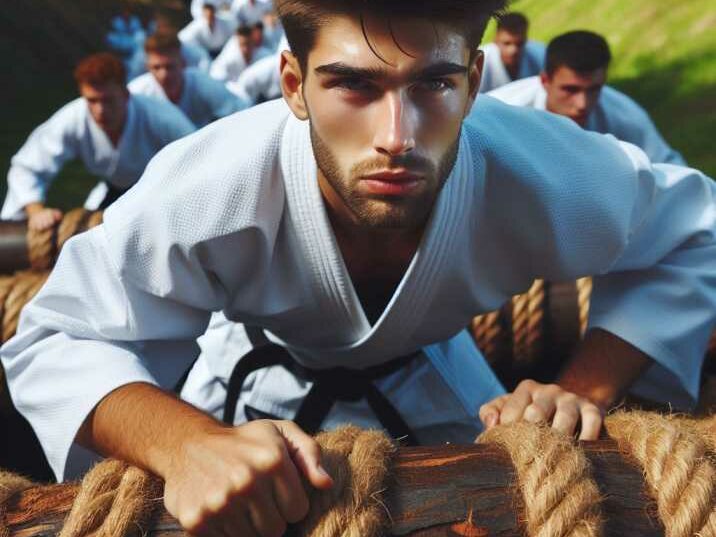Designing a Safe and Fun Obstacle Course for Young Martial Artists
Table of Contents
A group of young martial artists navigating a challenging yet enjoyable obstacle course, honing their skills while having a blast. Designing a safe and fun obstacle course for these enthusiastic learners requires a thoughtful approach. In this comprehensive guide, we’ll delve into the essential steps and considerations to create an obstacle course that not only enhances martial arts skills but also ensures the safety and enjoyment of every participant.
Crafting the Foundation
Introduction:
When it comes to fostering the growth of young martial artists, a well-designed obstacle course can be a game-changer. This article aims to guide you through the process of creating an obstacle course that strikes the perfect balance between safety and fun.

The Importance of Safety in Obstacle Course Design
Before we dive into the specifics of designing the course, let’s underscore the paramount importance of safety. Young martial artists are still developing their physical abilities, and a well-designed course should provide challenges without compromising their well-being.
Designing a Safe and Fun Obstacle Course for Young Martial Artists
To commence our journey, let’s understand the crucial steps in designing an obstacle course that caters to the unique needs of young martial artists. Safety remains the top priority, ensuring that participants can engage in physical activities without unnecessary risks.
Choosing the Right Obstacles
Selecting appropriate obstacles is the cornerstone of a successful course. Begin with obstacles that match the skill level of your participants. Incorporating elements that mimic martial arts movements adds an extra layer of relevance and engagement.
Ensuring Safe Landings
As we venture into the design specifics, it’s vital to address the importance of safe landings. Padded surfaces and strategic placement of crash mats can minimize the risk of injuries, allowing young martial artists to push their limits in a secure environment.
Striking a Balance Between Challenge and Safety
The heart of designing an obstacle course for young martial artists lies in finding the delicate equilibrium between challenge and safety. Let’s explore how you can achieve this balance to create an environment where participants can thrive.
Active Supervision: A Crucial Element
No obstacle course is complete without the presence of vigilant supervisors. Active supervision ensures that potential hazards are spotted and addressed promptly. This is particularly important when dealing with young martial artists, who may be eager to take on challenges beyond their current abilities.
Incorporating Transition Words for Easy Reading
To facilitate easy comprehension, let’s seamlessly transition to the topic of participant age groups. Understanding the age-specific needs and capabilities of your participants is essential for tailoring the course to their skill levels.
Age-Appropriate Challenges
Diversifying challenges based on the age of participants is a thoughtful approach. Younger martial artists may benefit from simplified obstacles, while older participants can tackle more intricate elements. This stratification enhances engagement and prevents frustration.
Incorporating Martial Arts Techniques
Our journey takes a fascinating turn as we explore the integration of martial arts techniques into the obstacle course. This not only reinforces their training but also adds an educational component to the fun.

Implementing Low-Impact Obstacles
Transitioning smoothly, let’s discuss the significance of low-impact obstacles. These elements minimize stress on joints, ensuring that the course remains accessible to young martial artists in various stages of physical development.
Ensuring Accessibility for All Participants
A well-designed obstacle course is inclusive, catering to the diverse abilities of young martial artists. Let’s explore how to make the course accessible to everyone, regardless of their physical capabilities.
Addressing Individual Needs
Participants may have varying abilities and requirements. Adaptable obstacles and personalized challenges accommodate the individual needs of each young martial artist, fostering a sense of inclusivity.

Conclusion:
In conclusion, the process of designing a safe and fun obstacle course for young martial artists is a journey of growth and enjoyment. By prioritizing safety, tailoring challenges to age groups, and incorporating martial arts techniques, you can create an environment where participants thrive and have fun while honing their skills.
Embark on this exciting venture of designing a safe and fun obstacle course, and witness the transformation of young martial artists as they navigate challenges with enthusiasm, determination, and joy.
Remember, the key is to strike a balance—providing a space for growth without compromising the safety and enjoyment of the participants.
FAQs:
- How do I choose age-appropriate obstacles? To select age-appropriate obstacles, consider the physical and cognitive abilities of each age group. Start with simpler challenges for younger participants and gradually increase complexity for older ones.
- What’s the significance of active supervision? Active supervision ensures that potential hazards are promptly addressed, creating a safe environment for participants. Supervisors should be engaged, vigilant, and ready to intervene if necessary.
- How can I address individual needs in an obstacle course? Tailor challenges to accommodate individual needs, considering factors like physical abilities and preferences. Providing options and adaptability ensures that every participant can engage comfortably.
- Why is low-impact important in obstacle course design? Low-impact obstacles reduce stress on joints, making the course accessible to participants in various stages of physical development. This inclusionary approach ensures that everyone can enjoy the experience.
- How can I optimize images for SEO? Optimize images by providing descriptive titles, alt text, and brief yet informative descriptions. Ensure that images are relevant to the content and strategically placed throughout the article for a seamless visual experience.
- What safety measures should be in place for an obstacle course designed for young martial artists? Safety is paramount when designing an obstacle course. Implement safety measures such as proper padding, clear signage, secure obstacle installations, and thorough participant briefings. Regular inspections and maintenance also play a crucial role in ensuring a safe environment.
- How can I involve parents or guardians in the obstacle course experience? Involving parents or guardians enhances the overall experience for young martial artists. Consider organizing family-friendly events, providing opportunities for parents to observe or even participate. Clear communication with parents about the course design, safety measures, and potential benefits for their children fosters a supportive community.
- Are there specific guidelines for incorporating martial arts techniques into the obstacle course? Integrating martial arts techniques requires careful consideration. Consult with martial arts instructors to ensure that the chosen techniques are age-appropriate and align with the participants’ skill levels. Clearly communicate the purpose of incorporating these techniques and provide guidance on their proper execution.
- How can I adapt the obstacle course for participants with different martial arts backgrounds? Adaptability is key to accommodating participants with diverse martial arts backgrounds. Consider incorporating challenges inspired by various martial arts disciplines, allowing participants to showcase their unique skills. Offering both individual and team-based challenges ensures inclusivity for participants with different training backgrounds.
- What role does teamwork play in a martial arts obstacle course, and how can it be encouraged? Teamwork fosters a sense of camaraderie and shared achievement. Design challenges that require collaboration, communication, and mutual support. Emphasize the importance of teamwork through debriefing sessions, encouraging participants to reflect on how working together enhances their overall performance and enjoyment of the obstacle course


